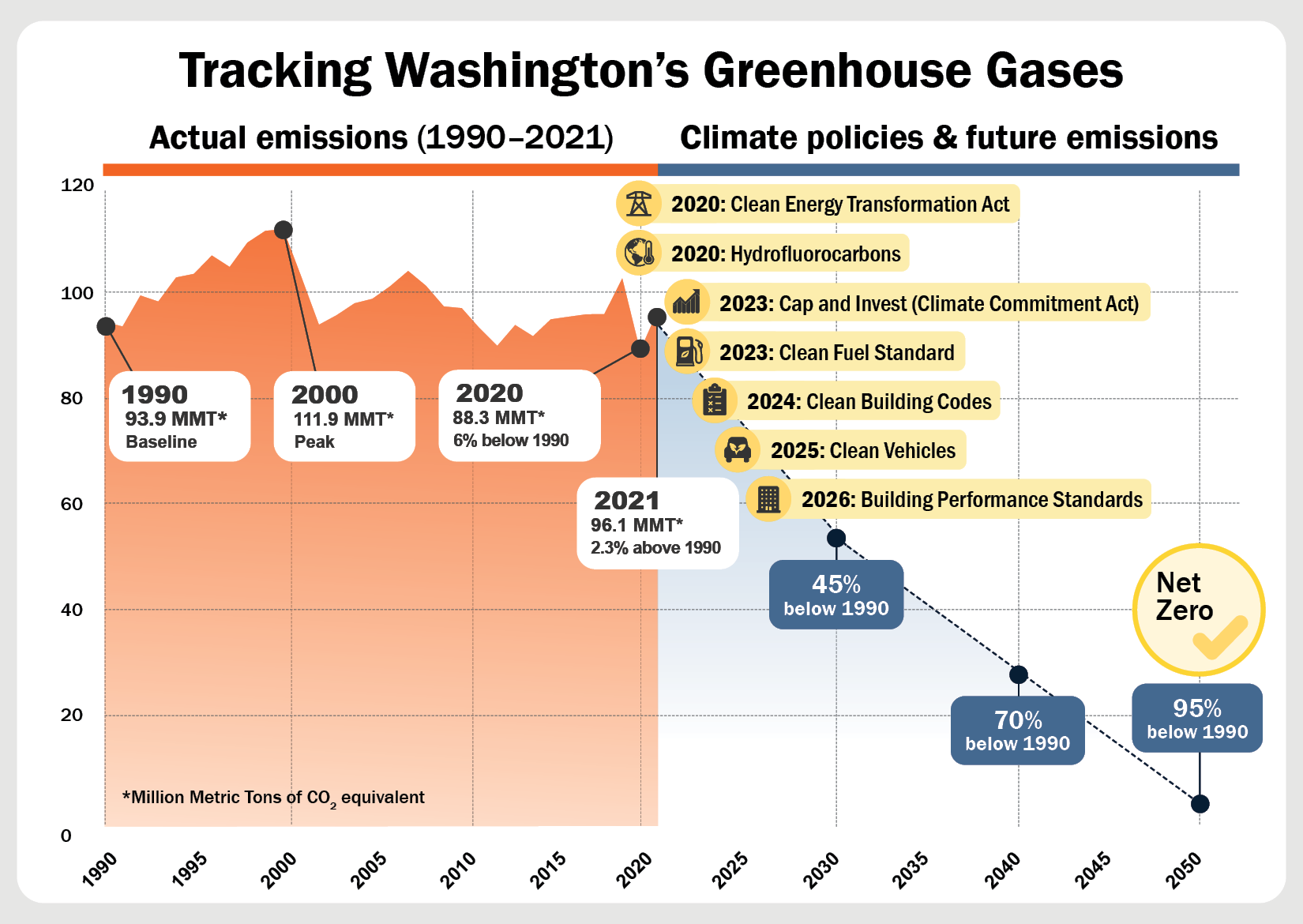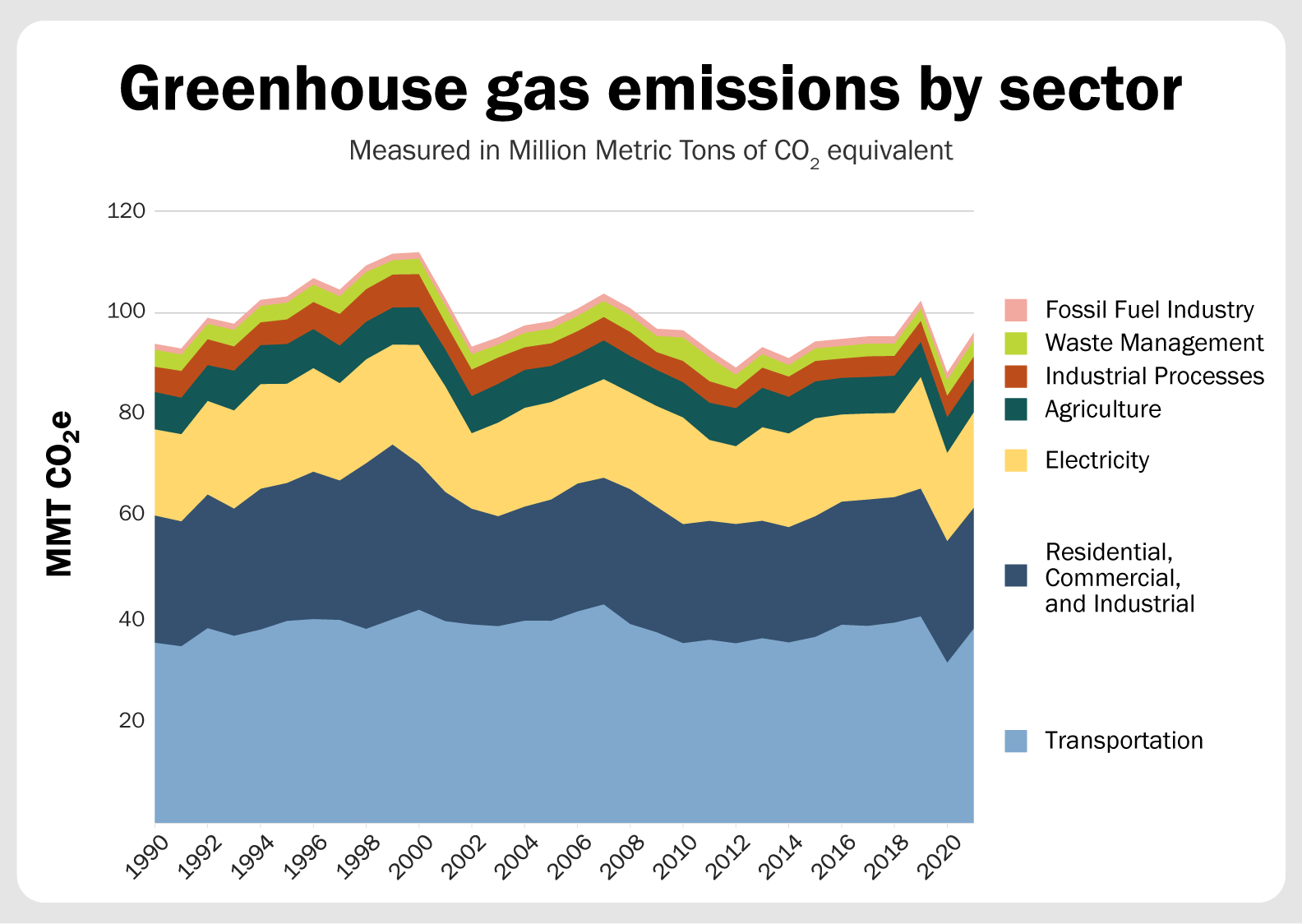A new report from the Washington Department of Ecology shows total state greenhouse gas emissions dipped 13.8% in 2020, falling below the legal limit for that year. Emissions rose 8.8% in 2021 but stayed below 2019 levels.
The partial emissions rebound in 2021 was driven by the transportation sector following the height of the COVID-19 pandemic. Transportation made up 86% of the increase and is still our state’s largest source of greenhouse gas emissions, underscoring the importance of new state policies designed to promote clean transportation: the Clean Fuel Standard and zero-emission vehicle standards.
“We expected to see a rise in emissions coming out of the pandemic,” said Ecology Director Laura Watson. “But we’re also seeing promising trends in energy efficiency, clean vehicle adoption and renewable energy production that will only grow stronger as a result of the climate policies Washington has put in place.”
The increase in transportation emissions was largely driven by non-highway sources, such as planes, boats and trains. Emissions from passenger cars and trucks remained well below pre-pandemic levels in 2021 — a sign that remote work altered commuting patterns — and are expected decrease further in the years ahead. Washingtonians are adopting electric and plug-in hybrid vehicles at record rates, and zero-emission vehicle standards will accelerate this trend.
The electricity sector made the most progress from 2019 to 2021, with emissions dropping nearly 15%. These gains were driven by record wind and solar production, alongside significantly lower coal and natural gas (methane) usage. An uptick in hydropower production also played a role. The Clean Energy Transformation Act, which took effect in 2021, will drive down emissions from this sector in the future by requiring electric utilities to transition to 100% clean electricity by 2045.
The Washington Legislature set legal limits on statewide greenhouse gas emissions based on the latest climate science in 2008. By 2020, the state was required to reduce total emissions to 1990 levels. This inventory shows that Washington’s emissions were 6% below the legal limit in 2020 and hovered 2.3% above the limit in 2021. By 2030, the state is required to bring emissions 45% below 1990 levels.
“It’s no secret that more work is needed to meet our 2030 limit, but we have a strong suite of policies in place to get us there.” said Joel Creswell, Ecology’s Climate Pollution Reduction program manager.
Most of Washington’s major climate policies, including the Climate Commitment Act, took effect after 2021. The collective impact of these policies will show up in future inventories. Ecology is also working toward providing more frequent updates to lawmakers and the public.
In 2008, Washington set legal limits on greenhouse gas emissions for 2020, 2030, 2040, and 2050. These limits are based on the latest climate science and require the state to reduce emissions by certain amounts compared to what emissions were in 1990. Washington has enacted a suite of policies to achieve these limits. This chart was updated Feb. 18, 2025.
The 2024 Greenhouse Gas Inventory at a glance:
-
Statewide emissions totaled 88.3 million metric tons of carbon dioxide equivalent (MMT CO2e) in 2020 — a decrease of 13.8% from 2019 and 6% below the 2020 limit.
-
Statewide emissions totaled 96.1 MMT CO2e in 2021 — an increase of 8.8% from 2020 and 2.3% above the 2020 limit.
-
2021 statewide emissions were 14% below their historical peak, which occurred in 2000.
-
Since 1990, per capita emissions have declined by 35.9% and emissions per dollar of gross domestic product have declined by 64.2%.
-
Transportation emissions rose 21.3% from 2020 to 2021, the steepest increase of any sector during that timeframe.
-
Aviation, marine and rail accounted for 78.9% of the rise in transportation emissions from 2020 to 2021.
-
Emissions from passenger cars and trucks dropped 19.9% in 2020 and only rebounded by 6.3% in 2021
-
Electricity emissions dropped 14.6% from 2019 to 2021, the biggest decrease of any sector during that timeframe.
-
Electricity emissions from coal dropped by 46.7% from 2019 to 2020 and rose by 8.6% in 2021. In 2022, they went down again by 5.7%.
-
Electricity emissions from natural gas (methane) dropped by 32.3% from 2019 to 2020 and rose by 11.9% in 2021. In 2022, they went down again by 19.1%.


